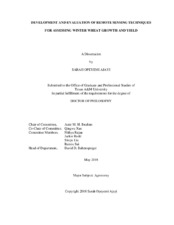| dc.description.abstract | Wheat (Triticum aestivum L.) production can be enhanced through the development of improved cultivars with wider genetic background, capable of producing higher yield under various agro-climatic conditions, biotic and abiotic stresses. Early growth stages in wheat can be influenced by many factors, such as planting date, type of cultivar, and water management, among others. It is essential to monitor the crop performance early by taking accurate measurements of crop growth parameters. Monitoring wheat performance during the growing season will provide information on productivity and prospects for realizing yield potential. However, monitoring conventional methods are time-consuming, labor-intensive and can cause large sampling errors. Remote sensing tools have provided easy and quick measurements of ground cover and aboveground biomass, without destructive sampling. The central objective of this research is to evaluate the performance of wheat genotypes using remote sensors on a ground-based plant sensing system, Greenseeker® , and manned aircraft system, under rainfed and irrigated conditions. Field experiments were conducted in the Texas A&M AgriLife Research Experiment Station at Bushland, Texas, in 2011-2012, 2012-2013, 2014- 2015 and 2015-2016 winter wheat growing seasons. Yield as the major desirable trait for plant breeders was associated with biomass at anthesis and maturity, harvest index, spikes m⁻², seeds m⁻², seeds spike⁻¹ and TKW. Spectral data from the remote sensors were taken during tillering, jointing, and heading stage, and used to compute eleven spectral vegetation indices. Results showed that significant variation exists among the genotypes using the indices at different growth stages. Field data included aboveground biomass, percent ground cover (%GC), and yield. The field data and vegetation indices had a significant relationship (R² = 0.30- 0.99, P˂0.05) with the %GC, aboveground biomass, and yield. %GC had the best estimation among the field data with a single index (R² = 0.84; training and R² = 0.94; validation, P˂.0001). Results indicate that the indices could be used as an indirect selection tool for screening a large number of early-generation lines and advanced wheat genotypes. Overall, this study illustrated the potential use of remote sensing techniques by wheat breeders for highthroughput phenotyping to screen for drought tolerant and high-yielding genotypes. | en |


